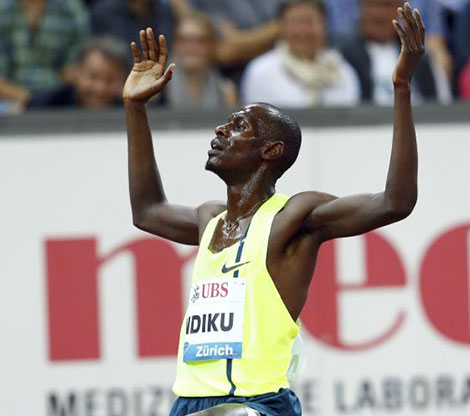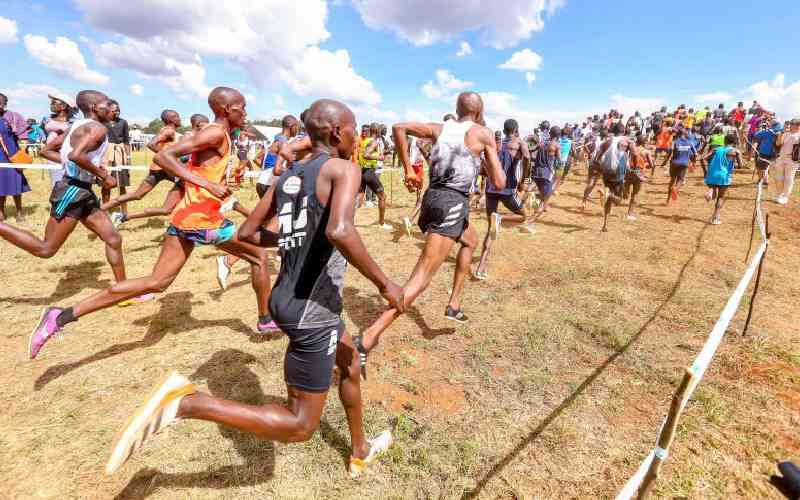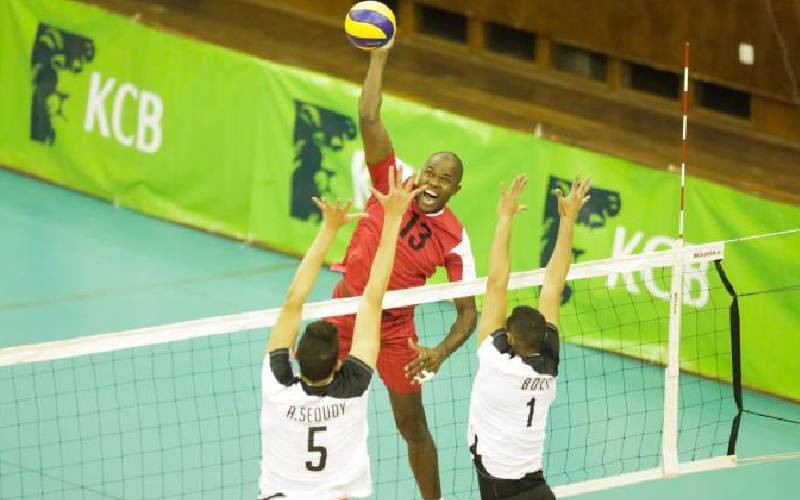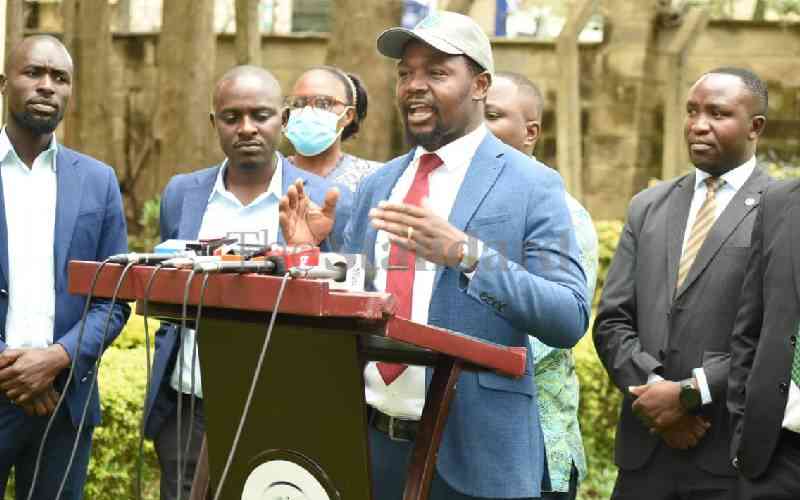 |
|
Caleb Mwangangi Ndiku of Kenya (C) celebrates winning the men's 5000 metres event during the Weltklasse Diamond League meeting at the Letzigrund stadium in Zurich August 28, 2014. REUTERS/Ruben Sprich (SWITZERLAND - Tags: SPORT ATHLETICS) |
It was a relatively low-key season in terms of performances in the men’s 5000m with only four athletes running faster than 13 minutes during the 2014 season. But one of these four was easily the best overall with the others running less consistently during the summer.
Caleb Ndiku, who had previously been a 1,500m specialist, started the season with a world indoor title over 3,000m. The 22-year-old Kenyan was unbeaten in his five total races in 3,000m and won all important 5,000m races as well.
Ndiku started his 5,000m season with a 13:01.71 world leader for a win in Eugene and then capped his season with major wins at the Commonwealth Games in Glasgow and African Championships in Marrakech. He later added a win at the Weltklasse in Zurich, right after finishing third in Stockholm in a 12:59.17 personal best. The Kenyan also won the Continental Cup 3000m in Marrakech in September.
Ethiopian Muktar Edris was the fastest runner of the year, winning in 12:54.83 in Stockholm. But his season was quite thin as in addition to this win and a second-place finish in Zurich, other results were moderate.
In fact, Yenew Alamirew, also from Ethiopia, was the second-best 5000m runner in 2014, despite the fact that his best of 13:00.21 was only the fifth-fastest time of the season. The 24-year-old recorded wins in Shanghai and Oslo and placed second in three further IAAF Diamond League meetings in Eugene, Paris and Glasgow.
Men’s 10,000m
There was one men’s 10,000m race this season which stood out over the rest. All four athletes who ran faster than 27 minutes this year came from the same race: the IAAF Diamond League meeting in Eugene.
USA’s Galen Rupp won in 26:44.36 to break his own North American record. It was also just the second time he had dipped below the 27-minute barrier, after his 26:48.00 in Brussels in 2011.
World bronze medallist Paul Tanui of Kenya was second in Eugene in 26:49.41 and was easily the most active runner at the top of the 10,000m this season. The 23-year-old ran three of the six fastest times in 2014 with an early world leader of 27:16.75 in May and then rounded out his season with 27:17.82 in Yamaguchi in October.
KAROKI WAS THIRD
Behind Rupp, Kenyans unbelievably populated the next 10 positions on the world list. Bedan Karoki was third in 26:52.36 and Stephen Sambu was fourth in 26:54.61.
With only a few meaningful titles in this event this season, Moses Kipsiro of Uganda grabbed the first one in a sprint finish in Glasgow at the Commonwealth Games. The 28-year-old clocked 27:56.11 for the win, just ahead of Kenyan Joseph Bett, who clocked 27:56.14 for the silver.
Eritrean Nguse Tesfaldet emerged as the African champion in Marrakech in 28:11.07 and Briton Mo Farah won his second career European title in 28:08.11 in Zurich.
Stay informed. Subscribe to our newsletter
MEN’S 300M STEEPLECHASE
Jairus Birech took a big leap towards the steeplechase elite in 2014. The 21-year-old Kenyan had run an 8:03.43 personal best back in 2012, but this season really changed things for the youngster.
Birech ran four of the five fastest times of the season and recorded IAAF Diamond League wins in Rome, Oslo, Lausanne, Monaco, Birmingham and Brussels. He also won the African Championships and the Continental Cup, both in Marrakech, with the only real dent to his campaign coming as a loss at the Commonwealth Games. There Birech finished in second place with fellow Kenyan Jonathan Ndiku grabbing the win.
Mahiedine Mekhissi-Benabbad was the second fastest of the season, clocking 8:03.23 for second place in Brussels. But the 29-year-old got a lot of the attention during the European Championships for being disqualified following his steeplechase win for ripping his shirt off in the final straight.
USA’s Evan Jager only ran his first steeplechase race in 2012 and after a disappointing 2013 season, he came back to the top in 2014. The 25-year-old finished second in Oslo and then broke his own North American record with a 8:04.71 clocking in Brussels before grabbing the second place at the Continental Cup in Marrakech.
Ezekiel Kemboi, who has won two Olympic golds and three world titles, had a quiet season. He started with an early world lead of 8:04.12 when winning the first IAAF Diamond League meeting in Doha in May. But after that the 32-year-old finished third at both the Commonwealth Games and African Championships and failed to perform at various IAAF Diamond League meetings.
Women’s 5000m
For quite a few years this event has had three main protagonists in Tirunesh Dibaba, Meseret Defar and Vivian Cheruiyot.
But all of them were missing in 2014; Dibaba only competed on the road while the other two took maternal leaves.
With no senior global outdoor championship, only the IAAF Diamond League could provide opportunities for global head-to-head competitions. But only two of the designated seven meetings featured the 5000m as four instead went for the 3000m and one for the two miles.
Thus the global season effectively consisted of just two significant races: Rome in early June and Monaco in mid-July. This is clearly reflected by the world list were the top 10 is made up of seven marks from Monaco and three from Rome.
The two races also turned out quite similar with Ethiopia’s Genzebe Dibaba and Almaz Ayana finishing first and second and Kenya’s Viola Kibiwott third on both occasions. The fastest times came in Monaco where both Dibaba and Ayana ran faster than 14:30. In sixth in that race, Molly Huddle of the USA lowered her own area record by a couple of seconds to 14:42.64.
The year also included some non-global championships. The Commonwealth title went to Kenya’s Mercy Cherono, the African title to Ayana – on that occasion defeating Dibaba – and the European title to Sweden’s Meraf Bahta after an exciting side-by-side battle down the finishing straight with Sifan Hassan of the Netherlands.
The Continental Cup in Marrakech in September featured only Ayana of the main contenders and the Ethiopian won by some 25 seconds in a relatively modest 15:33.
Women’s 10,000m
Outside of Japan – which has something that could almost be called a national 10,000m circuit – the 10,000m has become more or less completely restricted to the championships. The one exception to that is the Payton Jordan Invitational in Stanford, USA, in early May each year.
This year was no exception as the Stanford race was the by far fastest of the year. The top trio of Sally Kipyego, Molly Huddle and Betsy Saina ran 30:42.26, 30:47.59 and 30:57.30 respectively while the fastest time elsewhere was half a minute slower, 31:28.07 by Selly Chepyego in Japan in April.
Most of the championship races were fairly slow and decided by sprint finishes. Joyce Chepkirui of Kenya took the Commonwealth and African titles in 32:09.35 and 32:45.27 respectively while Great Britain’s Jo Pavey at age 41 won the European gold in 32:22.39.
Of the championship races, only the Asian Games in Inchon in October provided times faster than 32 minutes. Alia Mohamed Saeed of the United Arab Emirates won in 31:51.86 followed by China’s Ding Changqin in 31:53.09 and Japan’s Ayumi Hagiwara in 31:55.67.
It is worth noting that in 2014 there were 18 sub-32-minute runners on the track but 32 on the road, suggesting there is a great untapped potential readily available for the track event.
WOMEN’S 300M STEEPLECHASE
During the IAAF Diamond League era, this event has been dominated by runners from Kenya and Ethiopia who between them have won 23 of 28 races on the circuit between 2010 and 2013. The main contributor was Kenya’s Milcah Chemos who single-handedly accumulated 16 triumphs. -IAAF
 The Standard Group Plc is a
multi-media organization with investments in media platforms spanning newspaper
print operations, television, radio broadcasting, digital and online services. The
Standard Group is recognized as a leading multi-media house in Kenya with a key
influence in matters of national and international interest.
The Standard Group Plc is a
multi-media organization with investments in media platforms spanning newspaper
print operations, television, radio broadcasting, digital and online services. The
Standard Group is recognized as a leading multi-media house in Kenya with a key
influence in matters of national and international interest.
 The Standard Group Plc is a
multi-media organization with investments in media platforms spanning newspaper
print operations, television, radio broadcasting, digital and online services. The
Standard Group is recognized as a leading multi-media house in Kenya with a key
influence in matters of national and international interest.
The Standard Group Plc is a
multi-media organization with investments in media platforms spanning newspaper
print operations, television, radio broadcasting, digital and online services. The
Standard Group is recognized as a leading multi-media house in Kenya with a key
influence in matters of national and international interest.










